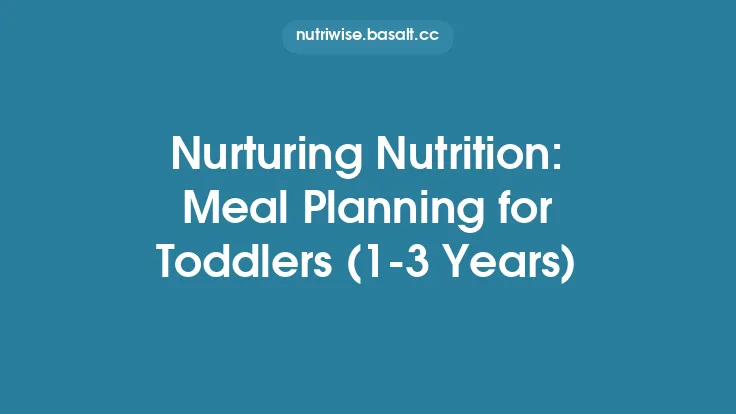Plant‑based eating offers a wealth of flavors, textures, and nutritional possibilities, but many people wonder how to structure meals so they consistently hit their protein targets while keeping the diet varied and nutritionally complete. This guide walks you through the practical steps of designing weekly menus that showcase the breadth of plant proteins, balance other essential nutrients, and stay realistic for everyday life.
Understanding Your Protein Needs
Before you can plan meals, you need a clear picture of how much protein you actually require. The general recommendation for adults is 0.8 g of protein per kilogram of body weight per day, but active individuals, older adults, and those recovering from illness may benefit from 1.0–1.6 g/kg.
- Calculate your baseline – Multiply your weight in kilograms by the appropriate factor.
- Factor in activity level – Endurance athletes often aim for the higher end of the range, while sedentary individuals can stay near the lower end.
- Distribute intake – Aim for 20–30 g of protein per main meal and 10–15 g for snacks. Spreading protein across the day improves muscle protein synthesis and helps maintain satiety.
Building a Balanced Plant‑Based Plate
A well‑rounded plate goes beyond protein. The goal is to combine macronutrients and micronutrients in a way that feels satisfying and supports overall health.
| Component | Typical Plant Sources | Approx. Portion for One Meal |
|---|---|---|
| Protein | Beans, lentils, nuts, seeds, soy‑free meat analogues, algae (e.g., spirulina) | ½ cup cooked beans or lentils, ¼ cup nuts/seeds, ½ cup tofu‑free analogue |
| Complex Carbohydrates | Starchy vegetables, whole‑grain alternatives (e.g., buckwheat, millet), tubers | 1 cup cooked grains or 1 medium sweet potato |
| Healthy Fats | Avocado, olives, nut butters, cold‑pressed oils | 1 – 2 Tbsp oil or ¼ avocado |
| Fiber & Micronutrients | Leafy greens, cruciferous veggies, colorful vegetables | 1–2 cups raw or cooked |
By ensuring each meal contains a source of protein, a carbohydrate, and a healthy fat, you create a nutrient‑dense combination that supports energy levels, hormone balance, and satiety.
Strategic Use of Diverse Protein Sources
Relying on a single protein source can lead to monotony and may miss out on the unique phytonutrients each food offers. Here are ways to rotate and combine proteins without repeating the same patterns:
- Legume Variety – Switch among chickpeas, black beans, split peas, and mung beans. Each brings a distinct flavor profile and micronutrient set (e.g., chickpeas are higher in folate, black beans in iron).
- Nuts & Seeds – Alternate between almonds, walnuts, pumpkin seeds, and sunflower seeds. They differ in omega‑3 content, vitamin E, and mineral composition.
- Mushroom & Mycelium Products – Incorporate oyster mushrooms, shiitake, or mycelium‑based “meat” alternatives for umami richness and B‑vitamin contributions.
- Algae & Sea Vegetables – Use spirulina powder in smoothies, nori sheets in wraps, or dulse flakes as seasoning to boost iodine and certain essential amino acids.
- Fermented Plant Proteins – Explore tempeh‑free fermented legumes (e.g., fermented lupin or chickpea tempeh) for enhanced digestibility and probiotic benefits.
By rotating these categories weekly, you naturally increase the spectrum of vitamins, minerals, and phytochemicals in your diet.
Incorporating Lesser‑Known Plant Proteins
While beans and nuts dominate many plant‑based menus, several underutilized foods can add excitement and nutritional depth:
- Lupin – High in protein (≈30 % by weight) and low in carbohydrates, lupin flour works well in pancakes, breads, or as a thickener for soups.
- Hemp Hearts – Soft, nutty seeds that provide a complete amino acid profile and a good dose of omega‑3 fatty acids. Sprinkle on salads or blend into oatmeal.
- Pea‑Based Isolates (non‑powder) – Whole‑green peas can be roasted and tossed into grain bowls for a crunchy protein boost.
- Jackfruit – When unripe, its fibrous texture mimics shredded meat; it pairs nicely with savory sauces and can be a base for tacos or “pulled” sandwiches.
- Edible Insects (optional for omnivores) – For those open to hybrid approaches, cricket flour adds protein and micronutrients like zinc and B12 without altering flavor dramatically.
Experimenting with these options keeps meals interesting and can address specific nutrient gaps (e.g., omega‑3s from hemp, iodine from sea vegetables).
Meal‑Prep Techniques for Consistency
Consistency is the secret to meeting protein goals without daily guesswork. Adopt these prep habits:
- Batch Cook Staples – Cook large quantities of beans, lentils, or whole‑grain alternatives on a weekend. Portion into airtight containers for quick assembly.
- Pre‑Portion Nuts & Seeds – Use small snack bags (≈¼ cup) to control portions and avoid over‑consumption of calories.
- Make Versatile Bases – Roast a tray of mixed vegetables with a drizzle of oil and spices; these can serve as the foundation for bowls, wraps, or soups throughout the week.
- Freeze Protein‑Rich Sauces – Blend cooked beans with herbs, spices, and a splash of broth to create a sauce that can be reheated and paired with different carbs.
- Label with Dates & Nutrient Info – A quick note on each container (e.g., “15 g protein”) helps you track intake at a glance.
These steps reduce daily decision fatigue and ensure you always have a protein‑rich component ready to go.
Seasonal and Budget‑Friendly Planning
Eating plant‑based doesn’t have to be expensive or limited to out‑of‑season produce. Here’s how to keep costs low while staying nutritionally robust:
- Buy Dried Legumes – Dried beans and lentils are far cheaper per gram of protein than canned versions and have a longer shelf life.
- Shop Farmers’ Markets Near Closing – Vendors often discount produce that’s still fresh but needs to be sold quickly.
- Utilize Frozen Vegetables – Frozen greens retain most of their nutrients and can be a cost‑effective protein‑friendly addition (e.g., frozen peas, edamame).
- Grow Your Own Herbs – Fresh herbs add flavor without extra protein, reducing the need for costly sauces.
- Plan Around Sales – If nuts or seeds are on sale, buy in bulk and store in the freezer to extend freshness.
Seasonal rotation also naturally introduces new flavors and textures, encouraging variety without extra effort.
Ensuring Micronutrient Adequacy
Protein is only one piece of the puzzle. Plant‑based eaters should pay special attention to nutrients that are less abundant in non‑animal foods:
| Nutrient | Primary Plant Sources | Strategies to Boost Absorption |
|---|---|---|
| Iron | Dark leafy greens, lentils, pumpkin seeds, dried apricots | Pair with vitamin C‑rich foods (citrus, bell peppers) to enhance non‑heme iron absorption. |
| Calcium | Fortified plant milks, tofu made with calcium sulfate, kale, bok choy | Include a serving of fortified product daily; limit oxalate‑rich foods (spinach) when relying on them for calcium. |
| Vitamin B12 | Fortified nutritional yeast, fortified plant milks, supplements | Regularly consume fortified foods or a reliable B12 supplement; check label for 100 % DV per serving. |
| Omega‑3 (ALA) | Flaxseed, chia, hemp, walnuts | Incorporate at least 1–2 Tbsp of ground flax or ¼ cup walnuts per day. |
| Zinc | Legumes, nuts, seeds, whole‑grain alternatives | Soak or sprout beans and grains to reduce phytate inhibition; consider a modest supplement if intake is low. |
| Vitamin D | Fortified plant milks, UV‑exposed mushrooms | Aim for 600–800 IU daily from fortified foods or a supplement, especially in winter months. |
A weekly checklist can help you verify that each nutrient is represented across meals, reducing the risk of deficiencies.
Sample Weekly Meal Plan Framework
Below is a flexible skeleton you can adapt to your preferences, dietary restrictions, and schedule. Each day includes three main meals and two snack ideas, with protein amounts noted.
| Day | Breakfast (Protein) | Lunch (Protein) | Dinner (Protein) | Snacks (Protein) |
|---|---|---|---|---|
| Mon | Overnight oats with hemp hearts (12 g) + berries | Quinoa‑free grain bowl with black beans, roasted veg, avocado (18 g) | Stir‑fried tempeh‑free chickpea “meat” with bok choy, brown rice (20 g) | Apple slices with almond butter (6 g); roasted pumpkin seeds (5 g) |
| Tue | Smoothie with spirulina powder, banana, soy‑free protein‑rich oat milk (15 g) | Lentil soup + side of whole‑grain‑free flatbread (16 g) | Baked jackfruit tacos with cabbage slaw, corn tortillas (14 g) | Carrot sticks with hummus (4 g); walnuts (4 g) |
| Wed | Savory buckwheat pancakes topped with mushroom “bacon” (13 g) | Mixed greens salad with lupin beans, olives, tahini dressing (17 g) | Coconut‑curry cauliflower stew with pea protein‑free chunks (18 g) | Orange wedges; hemp‑seed crackers (5 g) |
| Thu | Chia‑free pudding made with almond milk, topped with toasted coconut (10 g) | Veggie‑packed grain‑free wrap with roasted chickpeas and avocado (16 g) | Grilled portobello steak, side of millet‑free pilaf, steamed broccoli (19 g) | Celery with sunflower seed butter (5 g); a handful of edamame (6 g) |
| Fri | Tofu‑free scramble with nutritional yeast, spinach, bell peppers (14 g) | Cold soba‑free noodle salad with edamame, sesame, cucumber (15 g) | Stuffed bell peppers with lentil‑quinoa‑free rice blend (20 g) | Pear with cashew butter (5 g); roasted seaweed snacks (2 g) |
| Sat | Protein‑rich granola (almonds, pumpkin seeds) with fortified plant milk (12 g) | Buddha bowl: roasted sweet potato, black-eyed peas, kale, tahini drizzle (18 g) | Vegan “meatball” stew using lupin‑based balls, tomato sauce, spaghetti‑free pasta (22 g) | Mixed berries; a small serving of fortified cereal (8 g) |
| Sun | Pancakes made with chickpea flour, topped with almond butter (16 g) | Hearty bean chili with assorted beans, corn, avocado (20 g) | Grilled vegetable platter with hemp‑seed pesto, side of wild rice (15 g) | Trail mix (nuts, seeds, dried fruit) (6 g); a glass of fortified orange juice (2 µg B12) |
*Adjust portion sizes to meet your personal protein target. Swap any protein source for another of similar protein content to keep the plan fresh.*
Tips for Adjusting and Personalizing
- Scale Up or Down – Multiply or halve the portion sizes based on your calculated daily protein goal.
- Swap Ingredients – If you dislike a particular bean, replace it with another of comparable protein (e.g., replace black beans with navy beans).
- Mind Cooking Methods – Roasting, grilling, and sautéing develop flavor without adding excessive fat; steaming preserves micronutrients.
- Listen to Satiety Signals – Protein and fiber together promote fullness. If you feel hungry between meals, add a small protein‑rich snack.
- Track for a Week – Use a simple spreadsheet or nutrition app to log protein per meal; this helps identify gaps and refine future plans.
Tools and Resources
- Meal‑Planning Apps – Many free apps let you input plant‑based ingredients and automatically calculate protein content.
- Food Composition Databases – USDA FoodData Central, NutritionData, or local equivalents provide reliable macro‑ and micronutrient values.
- Batch‑Cooking Guides – Look for community cookbooks or online tutorials focused on large‑scale bean or grain preparation.
- Seasonal Produce Calendars – These help you select the freshest, most affordable vegetables and fruits each month.
- Supplement Guides – For nutrients like B12 and vitamin D, reputable health organizations publish dosage recommendations and product suggestions.
By approaching meal planning with a clear understanding of protein needs, a commitment to variety, and practical prep strategies, you can enjoy a plant‑based diet that is both nutritionally robust and endlessly interesting. The framework above offers a solid foundation; feel free to experiment, iterate, and make each week a fresh culinary adventure. Happy planning!





